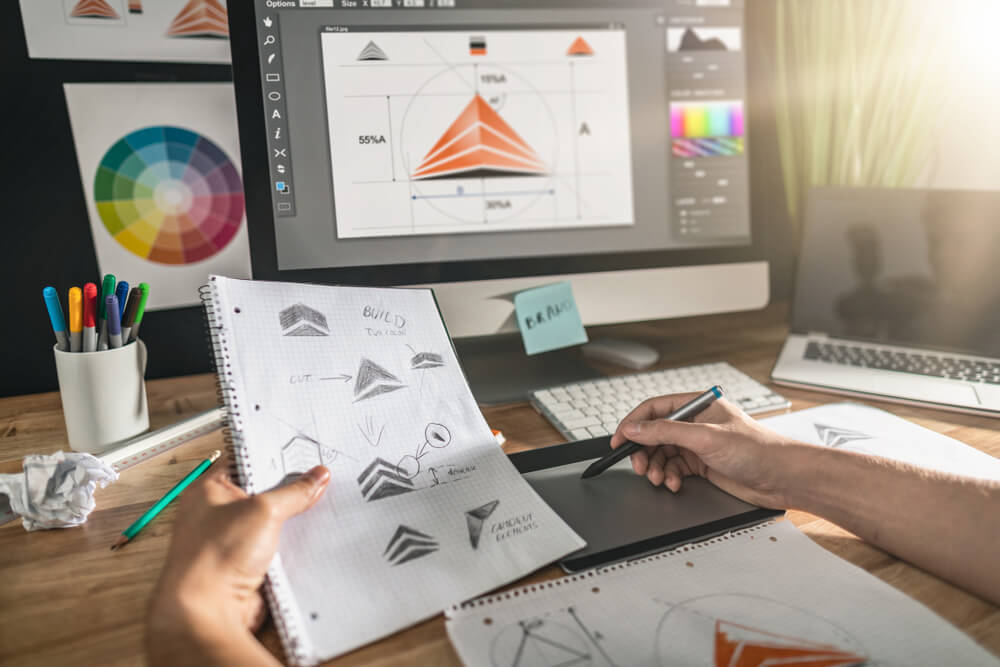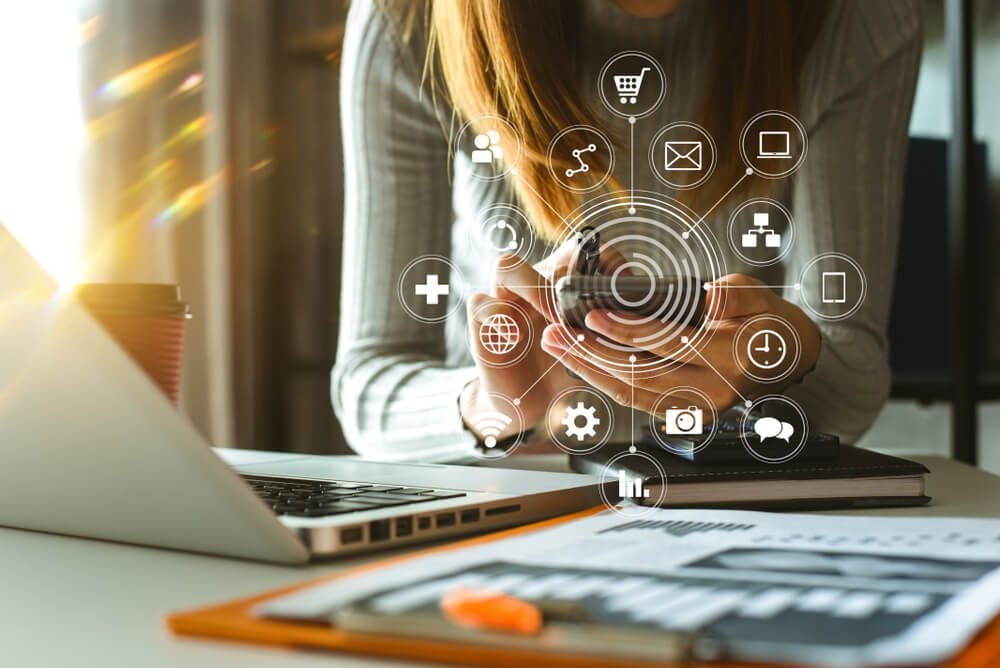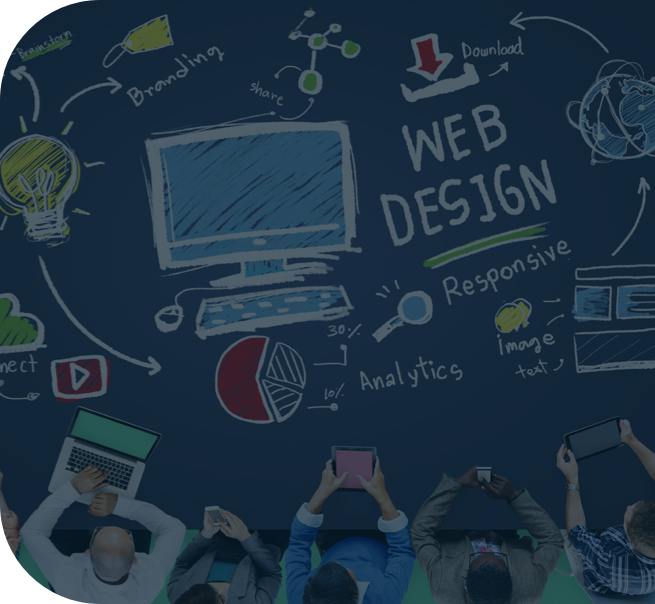
It’s no secret that the internet is very noisy, especially with more than 1.88 billion websites active today. A...
Digital design encompasses the design of anything you see in digital format such as monitors, mobile phones, tablets, laptops, etc. Digital designers work together with other team members to create brand consistent designs that support content and align with your goals.
Design plays an important role in user experience. Additionally, whether you have an established brand or are building a brand, design makes you instantly identifiable and relatable to your audience.
Design says something about you. It communicates your tone and style. Is your brand fun and energetic, sincere, serious, or professional? All of these qualities bring different images to mind. When you work with our designers they listen to you and then create emotional visual imagery that resonates with “your people.”
UX (user experience) refers to the collective digital interaction a user has with your product or service, while UI (user interface) refers to a specific digital asset your users are interacting with. A positive UI and UX will go a long way in differentiating your digital presence from competitors.
Indeed we can. In fact, we recommend a holistic approach to digital strategy considering all aspects of your digital buyer’s journey. You may already have a brand style guide, if not we can create one for you. Style guides ensure design consistency across all of your marketing channels. Keeping everything consistent with unified messaging and design is important to all of your marketing efforts.
We recommend, at minimum, one month of strategic upfront work. Depending on the scope of the project, this phase may last multiple months. We employ Agile methodology to produce the minimum viable product (MVP) in the shortest time possible and then continue iteration.
As the marketplace evolves, design preference and best practices evolve with it. The most successful companies are constantly reevaluating their design approach to better reach new and existing audiences and ensure continued growth of their business.
Have questions about your next project? Schedule a consultation with a DAP expert today and find out what we can do for your business.

App design helps increase app revenue by over 140% for the world’s leading physician application.
User-friendly credit card app design simplifies personal finance.
Page design optimization delivers 5x time on site improvement for travel brand.
Newly designed learning portal helps global non-profit reach more than 35K new students.
Digital design helps transform industry leaders user experience, contributing to a 10% increase in leads and engagement.
New landing page design drives local leads for software development company.

It’s no secret that the internet is very noisy, especially with more than 1.88 billion websites active today. A...

Design is the face of a website. It remains true that what is attractive is lucrative. Web design creates first impre...

In an era dominated by monster conglomerate web experiences (Facebook, YouTube, Amazon, etc.), the humble branded web...

And there’s a dizzying array of digital devices out there, with more being churned out month after month. As a result, digital designers must not only account for these various digital devices and platforms but also consider an exponential number of use cases for each one.
Digital design in and of itself comes in many different types and shapes, each serving a different purpose. You must understand all these aspects of digital design to create the best outcome, whether as a digital designer or for a particular digital design project.
As diverse a discipline as digital design is, it can be lumped into a few easy-to-digest categories, with each offering a unique set of advantages and challenges.
Today, we’re going to walk you through the nitty-gritty of digital design. We’ll cover:
Let’s dive in.
Digital Design
Is a broad-ranging field of design. It’s a generic term that describes a form of visual communication that can be interacted with on a digital device.
Digital design can represent a service, product, or information communicated visually through a digital interface, such as a computer screen. Another way to understand it is that digital designs are a form of graphic design created specifically for digital devices.
Unlike graphic designs, which typically appear in a static format, digital designs incorporate elements of interactivity or movement, such as three-dimensional modeling, interactive web pages, video, animation, and so forth.
Because digital design is interactive, a digital design agency is usually hired to create images, video, and other interactive design elements visually displayed on a screen, whether on an online dashboard, a mobile device screen, or a computer screen.
When all’s said and done, digital design is an umbrella term for any design created to appear or interact within a digital format, such as on a website or mobile app, instead of on a static page or in print.
The digital design world has made huge advances since the internet opened to commerce and marketing. Digital design now uses not just visual elements but also auditory elements like sound and audio effects to accentuate the visuals.
In layman’s terms, you could say digital designers create and produce designs for on-screen viewing. But the digital design space is much more wide-ranging and involves more than just viewing images and elements on a screen.
Because designs are created specifically for digital devices, designers must consider a wide variety of digital-facing factors such as interactivity, user experience (UX), data analytics, and much more. In a nutshell, digital designs are typically crafted to be interacted with or used rather than merely viewed or read.
There is still an overlap between digital and graphic design. For one thing, both categories of design focus on visual communication, usually concerning a brand, image, or idea. The goal of both a graphic designer and a digital design agency is to convey ideas and information to a target audience using imagery and symbols.
Graphic and digital design are powerful visual communication tools that create meaning for the reader or viewer. Compelling visuals make an emotional connection in the audience, helping with brand affinity and awareness.
Differences between Digital Design and Development
The commonality between digital and graphic design is that both are meant for visual communication. On the other hand, the distinct difference is that while digital designers create visuals for digital content, graphic designers do it for print. That also translates into how they make their products.
More specifically, graphic designers need ink and paper to create print works, while a digital design agency turns to code. Traditional graphic designs must go through a separate process that involves printing and distributing them. On its end, digital designers use a separate process for designing, creating, and deploying their codes. This process is known as development.
A digital design agency often brainstorms ideas and decides on the visual elements of the product, but it has to showcase a static mockup or prototype using tools like Photoshop, Adobe XD, or Figma. Once the client has approved the mockups, the projects go through the development phase. In this phase, the programming language is used to turn prototypes into functional digital designs, such as a mobile app, newsletter, or website.
Although full-service digital design agencies can sometimes take care of front-end development, digital design and development are two distinct fields that call for different sets of skills and best practices.
Types of Digital Design
The digital design field covers a broad range of digital devices and interfaces, each with its own set of benefits and use cases. Let’s take a look at the various types of digital design, so you can decide which best suits your needs.
– Web Design
When most people talk about digital design, this is most likely what they’re referring to. Web design is the most widely recognized form of digital design, because websites are as important and common for organizations nowadays as business cards and logos.
Web digital designs create web pages, logos, and other forms of website content. These sites serve as hubs for providing services, products, or information; often, they incorporate many different seeding pages. They are used for entertainment, commerce, business, information, and more.
– App Design
App designs typically look and work like web designs, but they’re created to serve a specific purpose, whether offering support, playing music, chatting, scheduling, or shopping. While often synonymous with the mobile ecosystem, apps can also be used on desktop computers.
– Email Design
The name says it all – email designs are created for communicating visually via emails. Marketing organizations use them for corporate communication purposes, helping build brand awareness and cohesive branding in the same way that printed letterheads do.
A well-executed email design can help catch and retain the reader’s attention so that they can read through the email content down to the bottom.
– Infographic Design
Infographics design uses engaging graphics to present data and information on a specific topic. Although they can be either digital or print, digital infographics often use interactive graphics and animations for storytelling and conveying the client’s message. They are an excellent choice for a brand that wants to create viral content that informs, engages, and entertains the reader.
– Landing Page Design
A subcategory of web design, landing page design often creates pages strictly for products to be used in marketing promotions. These designs are dedicated to a specific service, product, or campaign and typically include a call to action. Organizations often use a separate landing page for each of their services, products, or campaigns, and a digital design agency creates cohesion between them all.
– Ebooks
Electronic books (or ebooks for short) are digital documents that brands use to share information and other pieces of educational content with their audiences. As with traditional physical books, these electronic books include body typesetting and an attractive cover.
– Social Media Page Design
As the name suggests, social media page designers create images, avatars, infographics, videos, and other content on social media platforms like Facebook, Twitter, and Instagram. Although these designs often use photography, branding elements like logos can be repurposed to generate customer images for social media marketing.
– Banner Ads
Digital designers create banner ads for paid marketing purposes on search engines and web pages. They’re small ad snippets that use flashing or interactive elements to attract the attention of online users, helping increase online presence, boost brand awareness, and generate sales.
– 3D Design
3D designs are essentially three-dimensional products often used in animated films and video games. However, these 3D designers can also use this format to create prototypes and mockups for planned projects, especially for architectural and construction purposes.
– PowerPoint Template Design
PowerPoint has become an increasingly important tool for making presentations at conferences, trade shows, and boardrooms. Digital designers can also create branded templates for organizations for all their PowerPoint presentations. They can share updates with employees, business plans with clients, or generate sales pitches to sell to consumers or 3rd parties.
Roles in a Digital Design Company
Here’s the gist: not all digital design agencies are created equal. When you want to hire a digital designer, it’s essential to remember that the digital design disciplines are varied, each being handled by a different role in the company. As such, you’ll want to know the different roles in a full-service digital design agency, so you can be sure you’re hiring the right person for the job.
Web Designers
Web designers are responsible for the front-end designs of landing pages, websites, and other digital pages for desktop and mobile devices. They are trained and skilled at creating the layout and visual designs. In practice, web designers deliver mockups or prototype files for the client to hand over to their development team. Some can handle front-end development using coding languages like CSS and HTML.
Graphic Designers
Graphic designers are well-known in the design world. In the pre-internet era, they focused purely on creating print designs but now include branding elements for online use. They can help with color, typography, iconography, art direction, and graphic elements like illustrations in the digital design sense.
UI Designers
These digital designers focus on the user interface, often designing the actual text fields, buttons, and other interactive aspects. Their objective is to ensure the interface has a consistent, coherent, and pleasing appearance. Their deliverables include UI template sheets and style guides.
UX Designers
UX designers are all about the user experience. They leverage a mix of usability best practices and user research to generate UX frameworks for how a typical user will interact with the design. They often deliver UX prototypes, wireframes, or mockup files.
Product Designers
In some digital design agencies, the terms “UX designers” and “product designers” are used interchangeably and for good reason. The two roles are closely related, as they influence the user experience by choosing how a digital design functions and what features to include.
App Designers
App designers specialize in creating a mobile application’s layout and visual design. They typically incorporate the skillset of a UX designer or work closely with one. Their deliverables are usually offline mockup files that the client can hand off to the app development team.
Animators
Animators design custom animations as required for digital designs for websites, videos, marketing materials, etc. Unlike interaction designs that include slides, animators create more vivid and robust animations, like hand-drawn scenes that appear when a visitor lands on a homepage. Other examples include animated versions of the company’s logos and loading icons.
Visual Designer
The role of a visual designer is often mistaken for that of a graphic designer. In practice, however, the role of a graphic designer is wide-ranging. In contrast, a visual designer specializes in digital design’s appearance and feel elements, such as placement, sizes, and colors.
Interaction Designer
An interaction designer is closely related to an animator. However, they do more than create animated elements; they specialize in how the users interact with a digital design product. This role encompasses knowing user behavior, goals, and more in many respects. A UI designer or UX designer sometimes covers the role of an interaction designer.
Working with a Digital Design Agency
Hiring a digital design agency is a great way to bring a professional in to boost your brand awareness and enhance your online presence. However, you must be reading from the same script for your partnership to yield the results you want.
Here are some handy tips on working effectively with a digital design agency and accomplishing the best outcome.
– Get to know the agency’s design process
Creating truly standout and result-yielding digital designs can be a time-consuming process. While some digital design projects are a breeze, most take longer to materialize. The whole process will take several meetings, brainstorming, and reviews.
Because of that, you’ll want to understand the agency’s design process, so you can always know where your project is heading. By familiarizing yourself with the design process, you’ll learn the kind of emotions that you want your digital project to evoke in your target audience, as well as how and when to seek and get feedback from your target audience.
– Understand the importance of the whitespace
Whitespace is often seen as empty or wasted space, but white space is actually an essential part of clean, user-friendly digital design. It demarcates graphics and text, breaking them into easy to use and navigate sections. It also creates a more pleasant aesthetic and user experience.
– Study your target audience
Audience research is a crucial step towards a user-oriented design. When you know who your typical user is or who you want your audience to be, it’s much easier to understand what they need from your digital design product. For instance, if you know your website’s goals and your audience’s browsing behavior, you can tailor the design of your web pages and landing pages to meet their needs.
For inbound marketing campaigns, you can create and leverage buyer personas to help the digital design agency better understand your audience and what makes them tick. In addition, you must do competitor research to give a better picture of the audience that you’re not already targeting.
– Give designers your brand and technical guidelines
A good digital design agency will want to know the ins and outs of your organization, as well as the industry you’re in. You must play your part by providing their designers with your organization’s latest technical and brand guidelines, so that they can create design products consistent with your brand’s ethos and messaging.
It doesn’t have to be complicated; brand guidelines can be as straightforward as defining and documenting the core messaging, legal guidelines for copyrights, and acceptable usage of your branding assets, fonts, and colors. If you aren’t sure about all these elements, this is where an experienced digital design agency will come in handy, as their experts will be able to provide you with a punch list of the essentials.
– Loop in key stakeholders
You must get the input and approval of the key stakeholders, particularly senior management and those who will be responsible for the final product. Involving key people right off the bat will reduce the chances of friction and miscommunication down the line.
Conclusion
Digital design is a design created for viewing or use on digital devices. Hiring the right digital design agency is essential to boost your online presence and yield exciting results. Even so, you must understand the various roles in a digital design agency, such as app design, web designers, products designers, and UX designers, so that you can be sure you’re bringing in the right people for the project.